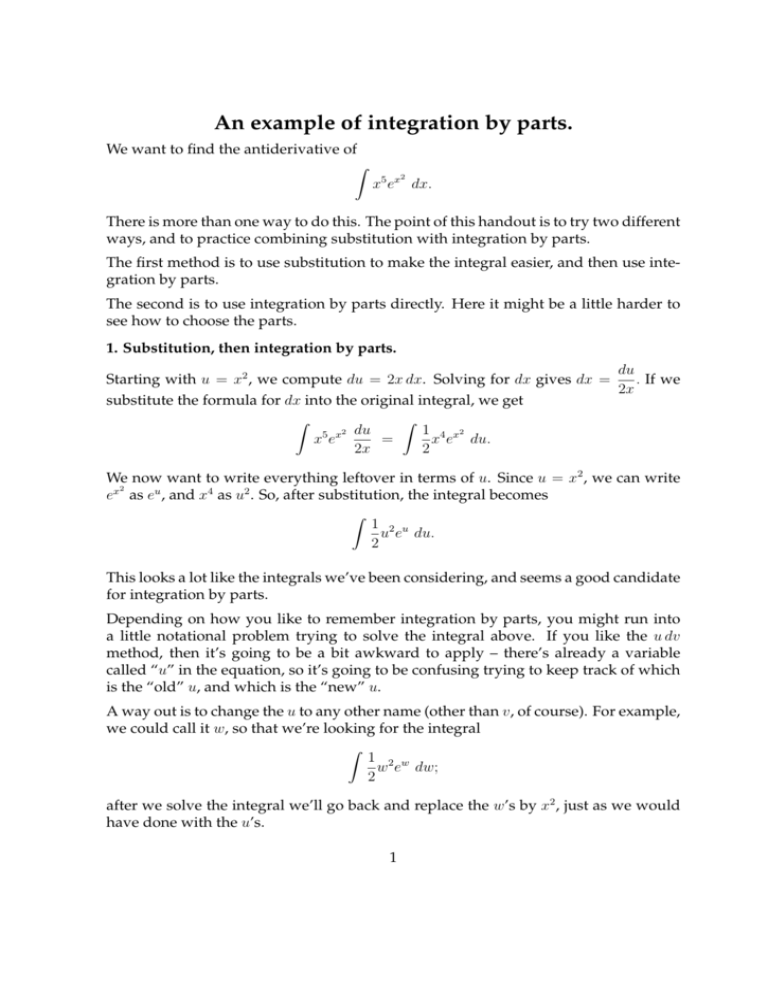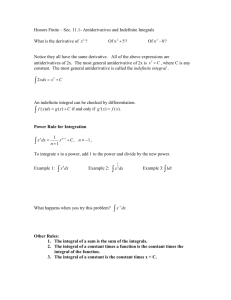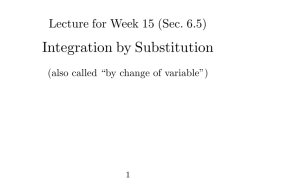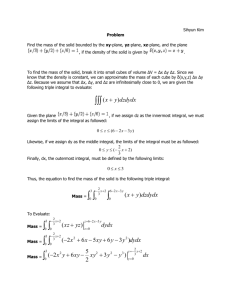An example of integration by parts.
advertisement

An example of integration by parts. We want to find the antiderivative of Z 2 x5 ex dx. There is more than one way to do this. The point of this handout is to try two different ways, and to practice combining substitution with integration by parts. The first method is to use substitution to make the integral easier, and then use integration by parts. The second is to use integration by parts directly. Here it might be a little harder to see how to choose the parts. 1. Substitution, then integration by parts. du . If we Starting with u = x2 , we compute du = 2x dx. Solving for dx gives dx = 2x substitute the formula for dx into the original integral, we get Z Z 1 4 x2 5 x2 du = x e du. xe 2x 2 We now want to write everything leftover in terms of u. Since u = x2 , we can write 2 ex as eu , and x4 as u2 . So, after substitution, the integral becomes Z 1 2 u u e du. 2 This looks a lot like the integrals we’ve been considering, and seems a good candidate for integration by parts. Depending on how you like to remember integration by parts, you might run into a little notational problem trying to solve the integral above. If you like the u dv method, then it’s going to be a bit awkward to apply – there’s already a variable called “u” in the equation, so it’s going to be confusing trying to keep track of which is the “old” u, and which is the “new” u. A way out is to change the u to any other name (other than v, of course). For example, we could call it w, so that we’re looking for the integral Z 1 2 w w e dw; 2 after we solve the integral we’ll go back and replace the w’s by x2 , just as we would have done with the u’s. 1 We’ve seen integrals like the one above before. We know that the way to apply integration by parts is to make sure that the w2 gets differentiated, and the ew integrated. The resulting integral will be simpler than the one we started with. In the u dv notation, that means that we set u = 12 w2 , dv = ew , diff du = w int v = ew . and that gives us Z 1 2 w 1 2 w (1) w e dw = w e − wew dw. 2 2 R w To deal with the second integral, we dw, we use integration by parts again. We use the same kind of pattern – differentiate w to reduce the power of w in the integral. Z Picking diff u = w, dv = ew , du = 1 int v = ew . we get Z w w we dw = we − Z ew dw = wew − ew . Now we can substitute the integral of wew back into equation (1), to get Z 1 1 2 w w e dw = w2 ew − wew + ew . 2 2 Finally, now that we know how to solve the integral in w, we substitute back in w = x2 to get the solution Z 1 2 2 2 2 x5 ex dx = x4 ex − x2 ex + ex . 2 2. Integration by parts directly. The trouble here is to figure out how to pick the parts to start off. 2 It’s tempting to try the same kind of trick – differentiate the x5 part and integrate ex 2 to try and simplify the integral. One problem is that there is no way to integrate ex by itself – it just can’t be done (and it’s a famous example of a function which can’t). 2 2 There is something closely resembling it which we can integrate: xex does have an 2 easy antiderivative, 12 ex (differentiate to see why). 2 2 That suggests that we split the product up as x5 ex = x4 · xex and differentiate the x4 2 piece and then integrate the xex piece. So, let’s set u = x4 , 2 dv = xex , so that we have Z (2) 5 x2 xe diff du = 4x3 int v = 12 ex . 2 1 2 dx = x4 ex − 2 Z 2 2x3 ex dx. R 2 To deal with 2x3 ex dx, we use integration by parts again. Again we’re faced with 2 the problem of integrating ex , and again we we’ll have to include an extra factor of 2 x with the ex to make it work out. diff u = 2x2 , 2 dv = xex , Z 3 x2 2x e int du = 4x 2 v = 12 ex . 2 x2 dx = x e Z 2 2xex dx − 2 2 = x2 ex − ex . Substituting this back into equation (2), we get Z 1 2 2 2 2 x5 ex dx = x4 ex − x2 ex + ex 2 just like before. The method of integration by parts directly may have seemed simpler, but it was perhaps less obvious how to choose the parts to make everything work out. 3. A common mistake. The most common mistake in trying to solve this integral is becoming confused about 2 the antiderivative of ex . A common guess is: 2 ex e dx = 2 , x +1 which comes from misapplying the rule for integrating xn – that rule only works when the exponent is a number, but doesn’t work when the exponent is a function. Z x2 3 Another common guess is to note that 2x to the denominator: Z d x2 e dx 2 = 2xex and try and “fix it up” by adding 2 x2 e ex . dx = 2x x2 That isn’t right either – when differentiating something like e2x the quotient rule has to be used, and its derivative is ! 2 2 2 2 d ex 2xex · 2x − ex · 2 ex x2 = = e − 2, dx 2x (2x)2 2x 2 which isn’t ex . 2 In fact, ex has no antiderivative that we can write down using any functions we 2 know. It’s a fact that’s worth remembering – if you see ex in an integral, you know you’re going to have to work around it somehow. 2 2 The only thing close to ex which we can integrate is xex . It doesn’t seem so different 2 from ex , but actually it is quite different, it has antiderivative we can find: Z 1 2 2 xex dx = ex . 2 That fact is why we had to pick the parts the way we did in section 2. This handout can (soon) be found at http://www.mast.queensu.ca/∼mikeroth/calculus/calculus.html E-mail address: mikeroth@mast.queensu.ca 4








